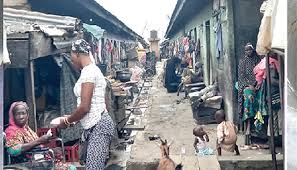
Inside Lagos lepers’ colonies where women give birth at home
Time seems to have stopped and humanity has turned its back on this place, which is located in the Jakande area of Alaba Rago in the state's Ojo Local Government Area, just beyond the clatter of scrap metal and the choking smoke of burning plastic.
Over 2,000 individuals, many of whom are leprosy survivors, reside in a colony called Lepers' Containment, which is located just out of sight and far out of mind behind a soaring mountain of abandoned iron and plastic waste.
First, the stink hits. It is bitter, caustic, and unrelenting, and it clings to the air like a curse. It is the smell of rot, trash, illness, and long-lost hope.
Their homes, if they can be called that, are flimsy constructions made from tarpaulin that has been eaten by mold, scavenged wood, rusted zinc, and whatever other trash they can find. It seems as if the weight of poverty has worn down even the shacks, as each one leans languidly into the next.
Children rush barefoot amid puddles of murky water filled with chemicals and decay. The hum of flies and the mechanical moan of the adjoining scrapyard drown out their pale, almost ghostly laughing. Their garments, old, discolored, and stiff from days without washing, hang loosely from their frames.
Under a roof patched with rags and rust, Umar Abdullahi awakens every morning and enters a world that few people even know exists, much less dare to enter.
Like the hundreds of homes surrounding it, his house rests perilously on the edge of a vast Lagos dumpsite, where the smell of rubbish permeates the air and condemned metal creaks beneath the weight of deterioration.
Weary-eyed and twisted from years of suffering, Abdullahi is more than simply a local; he is the reluctant patriarch of a people that has been forgotten.
He provides direction, comfort, and the glimmer of hope that remains above the muck to more than 2,000 leprosy survivors and their families in Nigeria. Even though the sickness has left his hands mangled and partially consumed, making it impossible for him to write or operate the chalkboard, his passion is unwavering.
Standing in front of a chalkboard in Kano, Abdullahi guided young minds with the gentle authority of a man who believed in the promise of education before the sickness seized his hands and cut away his place in society.
He was a well-respected educator for ten years, a source of order, wisdom, and serenity in classrooms full of restless hands and hungry eyes.
He would button his shirt every morning, pick up his lesson notes, and go through the sandy streets to a government school where pupils waited to read aloud from tattered textbooks, recite their multiplication tables, and dream—often aloud—about their future selves.
But the day the first symptoms showed up, that life started to go. His fingertips felt numb. a skin patch that refused to go away. The silent, insidious symptoms of a sickness that brought exile in addition to suffering.
After receiving a leprosy diagnosis in the early 1980s, Abdullahi saw his entire world fall apart. The educational system that used to support him abandoned him. His employment was terminated by the government, which swiftly condemned him. Neighbors stopped going to see each other, and friends grew apart. Due to fear and long-standing stigma, even his own community started to look through him rather than at him.
During a visit to the containment, Abdullahi told our journalist, "I was a Nigerian teacher for ten years. Regretfully, I developed this illness in 1981 or 1982, and the government laid me off and abandoned me.
Controlling leprosy
Leprosy is no longer the biggest problem for Abdullahi and his fellow citizens; rather, invisibility is.
They live in a sort of social quarantine, cut off from any obvious development goals or reintegration initiatives, and isolated by a culture still bound by superstition and fear.
With the help of the Ojo Local Government, they were given the Uthis area of land decades ago under Lateef Jakande's leadership.
It was intended to serve as a haven where leprosy patients may reside and recover in tranquility. Rather, it has turned into a prison for the dislocated and undesirable, where surviving is determined by one's determination to live rather than by official assistance.
Leprosy patients continue to be among the most marginalized in Nigeria. They are pushed to the periphery of society, not only physically but also politically and culturally.
They are still considered to be accursed, contagious, or cursed in many countries. Instead of being a treatable disease, it has become a life sentence of poverty, shame, and stigma.
Nigeria, the most populous country in Africa, is still one of the 17 countries that record more than 1,000 leprosy cases each year, despite having achieved the leprosy elimination target.
In addition to affecting the skin and peripheral nerves, leprosy is a persistent bacterial infection that can also affect other body areas, such as the eyes and the mucosa of the upper respiratory system.
If treatment is not received, it develops into a chronic illness that causes malformations and stigma that affects the sufferers’ lives.
“Leprosy is a neglected tropical disease which still occurs in more than 120 countries, with around 200,000 new cases reported every year. Elimination of leprosy as a public health problem (defined as a prevalence of less than 1 per 10 000 population as per World Health Assembly resolution 44.9) was achieved globally in the year 2000 and in most countries by the year 2010,” the World Health Organisation said.
Dwelling in filth
Residents of the containment, numbering over 2,000, with the majority survivors of leprosy, including men, women, and children.
During a visit to the camp, our correspondent witnessed how the lepers wallow in filth, a development predisposing them to several infections, making the place a possible epidemic hotbed.
Their settlement, long abandoned by meaningful government presence, was once a dense bushland populated by snakes, monkeys and crocodiles.
“We were the ones who cleared this land with our hands. We have been here since the 1980s. We were moved from Okokomaiko to settle here,” Abdullahi, a father of four, told our correspondent.
Decades later, their collective dreams of building a place they could call home have faded under the weight of neglect, disease, and indignity.
When rain falls, water seeps through holes and broken roofs of their shanties, soaking their mats and mattresses-which had already worn out from years of use-laid on bare earth.
Our correspondent observed that filth lurks around every corner that dot the camp. The large gutter behind the settlement is clogged with dark water thickened by years of stagnation.
The gutter, which was being cleared when PUNCH Healthwise visited the area, boasts of floating human faeces and several waste that could easily aid the spread of infections.
The absence of needed development has also forced the place to become a refuse dumping ground, with discarded debris from Africa’s largest electronics marketplace, the Alaba International market, finding a pride of place amidst the lepers.
Absence of potable water, toilets
Trudging further through the black mud that defined the corridor of camp, our correspondent observed a lack of running water and toilets.
It was gathered that the 2000 inhabitants of the camp depend on well producing brown water not fit for human use.
They had to resort to the well water after the only borehole serving the colony had been abandoned over lack of electricity. Also, the increase of pump price of petrol, occasioned by the subsidy removal, had limited their ability to fuel the generator set that could power the water pump.
“The only borehole we have was donated in 2008. But the engine needs fuel to pump water, and we don’t always have money to buy petrol. We are beggars; we have no job. We rely only on begging.
“Once in a while, we contribute money to buy fuel that we use in getting cleaner water from the borehole,” Abdullahi, now in his 70s, said dejectedly.
Once the water from the borehole can’t be pumped, the community leader noted that they resort to the well water, which is unclean, and uses alum as purifying agent.
“We use alum to purify the water and we wait three to four hours before drinking or using it to cook,” he added.
Aside from the water crisis, PUNCH Healthwise observed that there were no toilets. Residents, it was learnt, defecate in open fields at night, navigating mud and filth on foot or hands.
In their daily struggle to urinate or defecate, many of them crawl due to lost limbs while flies swarm freely, exposing them to infections.
Nylon becomes their choice of convenience during daylight, with every user disposing of their excreta tied in the used nylon into the gutter behind the camp, contributing to the thick offensive odour which hangs on the colony.
The nylon process, used when nature called, is brutal for those whose fingers are gnarled or feet amputated by the disease.
In Lagos lepers colony, the dwellers live amid their own waste.
“There are over 2,000 people here. Some live permanently with their families, and some come and go.
“We lack toilets. People go into the bush




